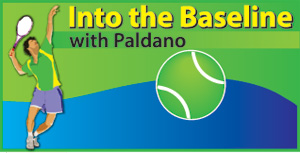AO’s Tennis made ‘difficult’
View(s): It is common to write about Tennis made easy. So, I am not sure if the title of this column is appropriate. To win a Tennis match at a Grand-Slam event, players must overcome the opponent which is a difficult task, accommodate the crowd and conditions, which is mental, and have the mastery over movement with speed and balance on ‘court’. In the Australian-Open (AO) it is the court that has become complicated in finding the comfort zone in stroke making, and strenuous to move on. It has posed a challenge bigger than usual.
It is common to write about Tennis made easy. So, I am not sure if the title of this column is appropriate. To win a Tennis match at a Grand-Slam event, players must overcome the opponent which is a difficult task, accommodate the crowd and conditions, which is mental, and have the mastery over movement with speed and balance on ‘court’. In the Australian-Open (AO) it is the court that has become complicated in finding the comfort zone in stroke making, and strenuous to move on. It has posed a challenge bigger than usual.
Movement on the court, judgment of the ball after the bounce and related shot selection is ‘habitual’ in a player. Habits are difficult to change in a time-squeezed situation of a Tennis match. Going by the number of players who had their legs strapped and foot plastered in this AO, one has to say the demand in accommodating the surface was a ‘Tennis made difficult’ situation. This aspect is much spoken subject in the world tour. In an effort to have a unique surface the AO have an unforgiving surface and challenges players to the limits.
Zverev’s Serve-&-Volley
The 3rd round match at the 2017 AO could have been a scenario from the era when the Australians conquered the world of Tennis with the ‘Serve & Volley’ game. Ranked 50, 30-year-old Russian-born German Mischa Zverev showed formidable ‘serve and volley’ ability to reach the Quarterfinals, beating World No.1 Andy Murray on his way. It is about the first time in decades, a player relying on the ‘serve and volley’ has done so well. His quarterfinal match against Roger Federer was an exhibition of Tennis rarely witnessed which was master class.
Zverev is a ‘set volley’ exponent and Federer at net is a ‘reflex volley’ exponent. No player can rally with volleys. This means, rallies must be short. The difference was very visible when Federer went to net, which he did many times, and outplayed Zverev very comfortably. On the other hand, Zverev’s set volley could only accommodate two shots comfortably. That did not put Federer out of challenge. Often, Federer, playing from inside the baseline, took the ball very early and passed Zverev very effectively with his fluent ground stroke. This gave Federer the edge to beat Zverev in straight sets. Most probably Murray did not have this ability of Federer.
Drama to Quarterfinals
The first two rounds looked very tame, except for the upset of Halep in the Women’s draw, but, on the 4th day, heads rolled. Women’s side lost its top seed in Germany’s Angelique Kerber and in the Men’s seeds No.1 Murray and No. 2 Djokovic were taken out of the draw. It could have been a nightmare for the organisers, if not for the fact, two old soldiers in each gender made the event exciting.
Roger Federer and Rafael Nadal have not seen the final rounds for a good while. They changed it in the 2017 AO. Nadal and Federer have reached the Semifinals. On the Women’s side, the William sisters have done the same. The Quarterfinals saw very crisp Tennis, with matches being won on thin margins. Old soldiers never die! As for Tennis, these 4 old soldiers produced the best.
Who could it be?
There are two new names in the Women’s draw in the Semifinals. They are USA’s Coco Vandeweghe and Serbia’s Lucie Baroni. Favourite Karolina Pliskova developed blisters on her foot and had medical time out twice, before losing to Lucie Baroni.
In the Men’s Semifinals, three have a won Grand-Slam. They are Federer, Nadal and Wawrinka. The 4th is Bulgaria’s Grigor Dimitrov. After his name-establishing debut in Wimbledon 2014, where he reached the Semifinals, only this year he got some success. He won the Brisbane event in the first week of January. If he wants a berth in the Finals, it is Nadal he must beat. Nadal is fresh from beating World No.3 Canada’s Milos Raonic, but could be tired.
So, in the prediction game, which is most dangerous to play with, all 4 semifinalists being very good, Wawrinka could be considered the man for the Singles title. He has stood solid and has the advantage of not being blown up by the press to create pressure. As for his playing ability, there is nothing he cannot do right now. His calm approach has a lot of calculating tactical strength in shot selection, and is capable of sustaining the game under tremendous pressure.
In the Women’s, the Williams are the favorites. Serena and Venus have the edge over Coco Vandeweghe, who beat World No.1 Angelique Kerber and Mirjana Lucie Baroni. Of the two sisters, it could be a toss of the coin.
Court’s challenge
Whoever wins will have to come to terms with the AO surface. True, they are professionals but, the surface they play on is unique and their freedom in shot section would be restricted. Moving to the ball will be challenging and enduring the strain, if the match goes to full length, cannot be taken for granted.
–George Paldano, Former intl. player; Accredited Coach of Germany; National, Davis-Cup, Federation Cup captain/coach– georgepaldano@yahoo.com


